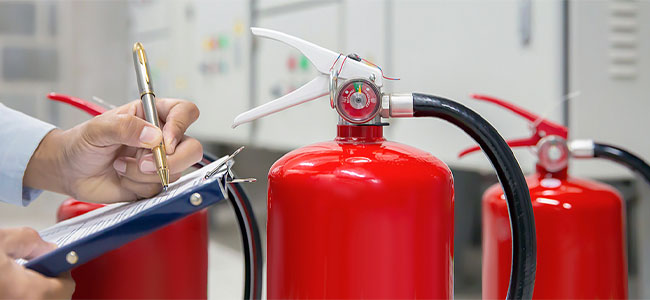
Page 2 of 2
Fire Extinguisher Facts that Every Safety Professional Should Know
When the portable fire extinguisher contractor conducts their annual inspection, do they pick up the fire extinguishers or just change the tag? In many cases, they just change the tag, which does not comply with NFPA 10 standards. One might ask, “How can you tell?”
Sometimes, the accumulation of dust can indicate that the portable fire extinguisher has not been picked up for some time. Manufacturers recommend shaking or using a rubber mallet to tamp the extinguisher monthly to prevent the powder from settling. To ensure proper functionality of the portable fire extinguisher, shaking or using a rubber mallet should be done annually by a third-party fire extinguisher contractor. If proper annual inspection and maintenance is not done, the effectiveness of the fire extinguisher will decrease from year to year.
Another issue that is commonly identified for portable fire extinguishers is that, every 6 years, a dry chemical fire extinguisher must have the powder changed. The extinguisher must be dumped, internally inspected and refilled with a dry chemical suppression agent. The calculation starts with the portable fire extinguisher’s date of manufacture. Rechargeable dry chemical extinguishers are stored-pressure fire extinguishers subject to a 12-year hydrostatic test.
NFPA 10 Section 7.3.6 requires the six-year internal examination of certain types of extinguishers. Every 6 years, stored-pressure fire extinguishers that require a 12-year hydrostatic test shall be emptied and subjected to the applicable internal and external examination procedures as detailed in the manufacturer’s service manual and this standard.
Suppose the safety auditor or inspector does not cite that a portable fire extinguisher is overdue for required service. In that case, they have missed a significant Fire Code violation that directly affects the overall safety of the facility it is installed in. Portable fire extinguishers are required in buildings because they are a stop-gap measure to prevent a small fire from becoming a big fire. Once the fire sprinkler system is activated, firefighters are at a disadvantage.
If a fire becomes large enough to activate the automatic fire sprinkler system, responding firefighters risk their lives and health to save others and protect property. If a fire is extinguished when it is small, the property is protected, and lives can be saved; the lives saved can include employees, staff, patrons and, yes, firefighters.
Safety inspectors work to ensure the safety of employees, staff and patrons of a given facility. Safety Professionals must be aware of fire protection systems and fire safety deficiencies.
About the Author
Tunzyaan Griffin is Married with five children, three boys and two girls. He currently works for HGS Engineering as a Certified Fire/ Building Inspector, Instructor, and Consultant. Tunzyaan is a Certified Firefighter, Fire Inspector, Fire Investigator, and Fire Command Officer. He also holds certifications in Digital Crime Scene Photography, OSHA 511, and Plans Review, among others. Tunzyaan has over 20 years of experience in Fire Inspection, Safety Inspection, and Codes and Standards enforcement. Tunzyaan has been involved in building construction starting with Plans Review, Plans Acceptance, Construction Initiation, Build out, Acceptance Testing, and Certificate of Occupancy. The completion of Building types includes Hospitals, Schools, Strip Malls, Covered Malls, Correctional Facilities, Office Buildings, Restaurants, and Assembly Occupancies. Tunzyaan is Currently a member of two NFPA Technical Committees, and an ICC Code and Standard Development Committee. Tunzyaan has two published articles in EHS Today (Environmental Health and Safety) Today online magazine.